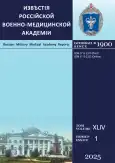Radiologic Features of Extrapleural Emphysema in Thoracic Injuries and Trauma
- Authors: Emelyantsev A.A.1, Zheleznyak I.S.1, Romanov G.G.1, Voronkov L.V.1
-
Affiliations:
- Military Medical Academy
- Issue: Vol 44, No 1 (2025)
- Pages: 5-17
- Section: Original articles
- URL: https://bakhtiniada.ru/RMMArep/article/view/310878
- DOI: https://doi.org/10.17816/rmmar634662
- ID: 310878
Cite item
Abstract
Background: This article explores the anatomical structure of the chest wall, with a particular focus on the extrapleural space, its radiologic visualization, and its role in the development of certain pathological processes following thoracic injuries and trauma. Among the pathological mechanisms involved in severe combined injuries that lead to life-threatening complications, the entry of air into internal body cavities is particularly significant. One such complication is tension pneumothorax. According to the clinical guidelines issued by the Main Military Medical Directorate, pleural drainage is recommended as a therapeutic measure at the stage of qualified or specialized medical care upon diagnosis of pneumothorax, regardless of its type.
AIM: To assess the diagnostic capabilities of imaging modalities for identifying extrapleural emphysema in chest injuries and trauma.
MATERIALS AND METHODS: The primary imaging techniques for diagnosing pneumothorax are chest radiography and ultrasound. According to both domestic and international literature, these methods demonstrate high specificity, approaching 100%.
RESULTS: In our study, systematic use of computed tomography revealed distinctive radiologic signs of air in the extrapleural space in the absence of parietal pleura damage. On radiographs, these conditions appear as a radiolucent stripe along the inner surface of the chest wall. On ultrasound, they are visualized as a “sandy beach” sign with absent visceral pleural sliding, which is often mistakenly interpreted as pneumothorax. In such cases, attempts to drain the pleural cavity increase the likelihood of chest tube misplacement into the extrapleural space due to disrupted anatomical relationships within the chest wall layers. In cases of inadequate medical management during patient transport, subcutaneous emphysema tends to progress.
CONCLUSION: Thus, identifying air in the extrapleural space helps avoid unnecessary invasive procedures and additional iatrogenic injuries. Our study identified key radiographic features that distinguish extrapleural emphysema from pneumothorax: predominant localization in the basal regions, well-defined borders, and the presence of concurrent subcutaneous emphysema and pneumomediastinum.
Full Text
##article.viewOnOriginalSite##About the authors
Alexander A. Emelyantsev
Military Medical Academy
Author for correspondence.
Email: yemelyantsev@gmail.com
ORCID iD: 0000-0001-5723-7058
SPIN-code: 6895-7818
MD, Cand. Sci. (Medicine), Senior Lecturer of the Radiology Department
Russian Federation, Saint PetersburgIgor S. Zheleznyak
Military Medical Academy
Email: igzh@bk.ru
ORCID iD: 0000-0001-7383-512X
SPIN-code: 1450-5053
MD, Dr. Sci. (Medicine), Professor, the Head of the Radiology Department
Russian Federation, Saint PetersburgGennadiy G. Romanov
Military Medical Academy
Email: romanov_gennadiy@mail.ru
ORCID iD: 0000-0001-5987-8158
SPIN-code: 9298-4494
MD, Cand. Sci. (Medicine), Associate Professor of the Radiology Department
Russian Federation, Saint PetersburgLeonid V. Voronkov
Military Medical Academy
Email: lvoronkov83@mail.ru
ORCID iD: 0000-0002-0780-0735
SPIN-code: 5709-5316
MD, Cand. Sci. (Medicine), Senior Lecturer of the Radiology Department
Russian Federation, Saint PetersburgReferences
- Sugarbaker DJ, Jaklitsch MT, Bueno R, et al. Prevention, early detection, and management of complications after 328 consecutive extrapleural pneumonectomies. The Journal of Thoracic and Cardiovascular Surgery. 2004;128(1):138–146. doi: 10.1016/j.jtcvs.2004.02.021
- Bychkov MB, Bolshakova SA, Bychkov YuM. Pleural mesothelioma: modern treatment tactics. Modern oncology. 2005;7(3):142–144. EDN: SYSNOR
- Borovitsky VS. Modern methods of treatment of chronic destructive forms of tuberculosis using the example of fibrocavernous tuberculosis. Pulmonology. 2014;(1):102–108. EDN: SAHXDD
- Vummidi DR, Chung JH, Stern E. Extrapleural fat sign. J Thorac Imaging. 2012;27(5): w101. doi: 10.1097/RTI.0b013e31825fdfde
- Hammerman AM, Susman N, Strzembosz A, et al. The extrapleural fat sign: CT characteristics. J Comput Assist Tomogr. 1990;14(3):345–347. doi: 10.1097/00004728-199005000-00004
- Im JG, Webb WR, Rosen A, et al. Costal pleura: appearances at high-resolution CT. Radiology. 1989;171(1):125–131. doi: 10.1148/radiology.171.1.2928515
- Santamarina MG, Beddings I, Lermanda-Holmgren GV, et al. Multidetector CT for evaluation of the extrapleural space. RadioGraphics. 2017;37(5):1352–1370. doi: 10.1136/emermed-2012-201258
- Sakai M, Hiyama T, Kuno H, et al. Thoracic abnormal air collections in patients in the intensive care unit: radiograph findings correlated with CT. Insights Imaging. 2020;11(1):35. doi: 10.1186/s13244-020-0838-z
- Belskikh AN, Samokhvalov IM, Grebenyuk AN, et al. Instructions for military field surgery. 8th ed. Moscow: Main Military Medical Department Ministry of Defense of the Russian Federation; 2013. P. 474. EDN: WFZYTA
- Trishkin DV, Kryukov EV, Chuprina AP, et al. Methodological recommendations for the treatment of combat surgical trauma. Saint Petersburg: S.M. Kirov Military Medical Academy; 2022. P. 373. EDN: MHOUOD
- Voskresensky OV, Beresneva EA, Sharifullin FA, et al. Preoperative X-ray examination in the choice of treatment tactics for chest wounds. Surgery. Journal named after N.I. Pirogov. 2011(9):15–21. EDN: PIOKPH
- Blaivas M, Lyon M, Duggal S. A prospective comparison of supine chest radiography and bedside ultrasound for the diagnosis of traumatic pneumothorax. Acad Emerg Med. 2005;12(9):844–849. doi: 10.1197/j.aem.2005.05.005
- Dorovskikh GN. Comparative analysis of the sensitivity and specificity of various methods of radiation diagnostics for polytrauma. Bulletin of the East Siberian Scientific Center of the Siberian Branch of the Russian Academy of Medical Sciences. 2014;98(4):24–28. EDN: TIGETN
- Alrajab S, Youssef AM, Akkus NI, et al. Pleural ultrasonography versus chest radiography for the diagnosis of pneumothorax: review of the literature and meta-analysis. Crit Care. 2013;17(5):208. doi: 10.1186/cc13016
- Samokhvalov IM, Kryukov EV, Markevich VYu, et al. Ten surgical lessons of the initial stage of a military operation. Military Medical Journal. 2023;344(4):4–10. EDN: DSYIAP doi: 10.52424/00269050_2023_344_4_4
Supplementary files
















